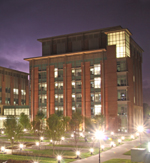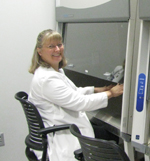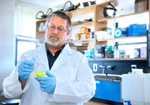|
 Imagine trying
to put a puzzle together with
the pieces in different rooms. Imagine trying
to put a puzzle together with
the pieces in different rooms.
Now consider
how much faster the process
would be if the pieces were
brought together first. That's
the analogy used by Charles
Smith, Ph.D., the Charles and
Carol Cooper Endowed Chair in
Pharmacy and SmartState Endowed
Chair to explain the
significance of MUSC's
114,000-square-foot Drug
Discovery Building.
Holder of many
patents, he was recruited to
MUSC from Penn State University
to direct the Drug Discovery
Core. Smith is an expert in high
throughput screening. He designs
drugs to fight cancer by
unlocking molecular mechanisms
important for preventing tumor
growth. Smith believes the
building, which bundles research
labs together, will heighten
creative collaboration and
productivity.
"The building
will help integrate the process
of drug discovery and
development. Proximity helps to
generate collaboration, and the
building brings together
multiple disciplines," said
Smith.
 Dr. Donna S.
Harrison, associate professor in
SCCP, loves the lab funded by
CVS. Dr. Donna S.
Harrison, associate professor in
SCCP, loves the lab funded by
CVS.
This
coordination is essential, given
the lengthy process of drug
discovery.
For example,
it takes more than $800 million
and 15 years to bring a new drug
to market, and fewer are making
it despite advances in
understanding diseases
processes.
Private
industry, driven by investors'
need for larger returns on
guaranteed winners, has
increasingly turned to lifecycle
management of existing products
rather than early-stage
discovery. This opens up an
opportunity for academic
researchers to drive the early,
more innovative steps in drug
discovery. Nevertheless,
academic institutions often lack
the resources and infrastructure
needed to conduct high-risk,
high-reward drug discovery
research that could lead to the
next breakthrough.
Despite this
intimidating environment for
discovery, business and
educational leaders in South
Carolina point to biomedical
research as a potential economic
powerhouse for the state. Enter
the Drug Discovery Building,
part of the
James E.
Clyburn Research Center, as a
way to fill the gap.
The building
is situated on the MUSC campus,
but the scientists within it
represent direct collaboration
among MUSC, Clemson University
and the University of South
Carolina, as well as existing
and new partnerships with the
private sector.
Rick
Schnellmann, Ph.D., chair of the
Department of Pharmaceutical and
Biomedical Sciences at the South
Carolina College of Pharmacy
(SCCP), believes that innovative
drug discovery has to be a
collaborative process.
"The most
effective way to move from
academic research to an
FDA-approved product that can
help a patient is through
partnerships between the
academic and private sectors,"
said Schnellmann.
"On our end,
we need the right basic
scientists in place to drive the
research to the point that will
appeal to private industry for
further development, which will
get the drugs patients need into
the market," added Schnellmann.
The Drug
Discovery Building plays a big
part in getting the right basic
scientists in place. The state's
investment in the Centers of
Economic Excellence, designed to
draw the nation's top scientists
to the state as SmartState
Endowed Chairs, is paying off in
part because of the promise
MUSC's investment in drug
discovery represented for
candidates.
Patrick
Woster, Ph.D., is a prime
example. Woster, a SmartState
Endowed Chair in Drug Discovery
and Professor of Pharmaceutical
and Biomedical Sciences, arrived
in 2011 bringing a much-needed
specialization to the drug
discovery process.
 Dr. Patrick
Woster is an expert in
medicinal chemistry. Dr. Patrick
Woster is an expert in
medicinal chemistry.
"I was drawn
to my position by the reputation
of MUSC as an emerging power in
biomedical research, and by the
numerous opportunities to
conduct collaborative research
aimed at the discovery and
development of new therapeutic
agents," said Woster.
There are
several cores and research foci
represented in the new building,
which will take advantage of the
pooled expertise in drug
discovery and state-of-the-art
technologies.
In many ways,
Smith and Andrew Kraft, M.D.,
director of Hollings Cancer
Center (HCC) and Dr. William H.
Folk Chair in Experimental
Oncology, exemplify what the new
Drug Discovery Building makes
possible. Kraft is a medical
oncologist and nationally
recognized researcher who led
HCC to become a National Cancer
Institute-designated cancer
center.
HCC is just one of 66 in the
U.S., and the only center in
South Carolina, to hold that
designation from the National
Cancer Institute. This
distinction is awarded to
centers conducting the most
advanced research and clinical
trials.
Smith and
Kraft collaborated on research
into inhibitors of Pim protein
kinases, which play a role in
the development of T-cell
lymphomas and prostate cancer.
They screened a library of
50,000 chemicals for novel Pim-1
inhibitors, identifying
compounds that effectively
inhibit the kinase, which could
lead to novel anticancer drugs.
The potential impact of this
discovery on patients is
significant. Very few compounds
have been identified as Pim
inhibitors, and those that have
are poorly selective, leading to
non-specific toxicity and lack
of clinical utility.
Drug discovery
is one mechanism for economic
development. High tech,
medically-focused technology is
increasingly important as we try
to develop safer and more
effective drugs for many
diseases. Building many new
small companies to create a
biotech cluster in Charleston
could have a significant
economic impact.
|




 Dr. Donna S.
Harrison, associate professor in
SCCP, loves the lab funded by
CVS.
Dr. Donna S.
Harrison, associate professor in
SCCP, loves the lab funded by
CVS.  Dr. Patrick
Woster is an expert in
medicinal chemistry.
Dr. Patrick
Woster is an expert in
medicinal chemistry.